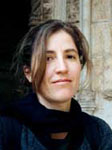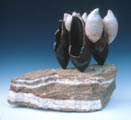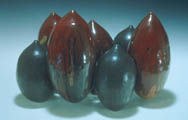jennifer s. otis 
iowa city, iowa | interviewed 2-28-2002
biographical sketch | artist's statement | interview clips

"One in Nine"
stoneware sculpture
"Cacela Velha "
stoneware sculpture
"Plum"
stoneware sculpture
(click images for larger view)
All images copyright © 2001 Jennifer S. Otis | All Rights Reserved
interview clips (mp3 audio & text)
I think that my work contains ideas that are spiritual and that don't fit into one category. I draw heavily from Asian pots, and Asian philosophy is heavily in Asian pots. One of my favorite recent books is one of the many books the Dalai Lama wrote, and his ideas about life and the philosophy of life are present in my work. I'm not really trying to express myself so much as I am trying to express ideas. It's not a story about me.
I felt like I was going through the motions for about a month, when I would go to my studio and when I did teach—Ooh, how do you talk about it, how do you not talk about it, even with your students. Everybody's just trying to kind of play it cool and be strong, you know, go back to work, and that kind of thing. There's a real uncertainty—I think we're living in a totally different time than we were this time last year. And I think that a lot of people realize that.
I went more into making pots. And I went into that kind of comfort thing—it didn't require a whole lot of my creative energy. And then the pieces that I did end up making after that were influenced by that and how I treated their surface. I went to some extremes, like cutting some of them open, or one became just more black and white, or black and red, which were choices I wouldn't have made prior to that. I think I would have gone more, you know, blue to white or subtle. But I used black—it's symbolic of absence. It's more graphically stark.
Cacela Velha—it's a town near Tavera, Portugal, which is south near Spain. You can walk down from a high overlook and go straight down to the Mediterranean, and as you make that descent, there's a rocky cliff and there's just a lot of stark contrasts, and it's a very intense place. I put an actual rock with my ceramic forms. And the sense of timelessness and the relationship between people who live in a place, and then what stays behind is the rock, is kind of interesting. Making it, I was thinking, all of this will pass. I've been to Spain and Portugal, and I just feel like the culture is so old compared to the United States. So you get this feeling, like, this will pass—meaning this conflict, specifically. And there are open forms and closed forms, and I think the open forms represent things that have passed, and the closed forms are hope for the future.
I chose specifically not to do something that comments directly on this situation. I think sometimes when you make artwork about something, at least for me, it perpetuates the problem instead of solving it, so I tend to not make work that is rooted in a huge problem. I think I tend more towards beauty, and the power that that has, and that's really where I want to put my thoughts and my energy.
We're in a country that has some privileges, but it's not a luxury to be an artist. It's one of the most important roles, like social conscience thinkers that instigate ideas—people who really think and communicate really well. I'm not saying any of this was really our fault, but there are a number of things that we need to figure out as a culture, and that's where art comes in for me. It's not decorative, it's not about making money—it's about communicating.
biographical sketch
Jennifer S. Otis was born in Iowa City, Iowa in 1968, and grew up there as well.
She earned her B.A. from St. Olaf College, and her Certification for K-12 Art Education, M.A. in ceramics/sculpture, and M.F.A. in ceramics/sculpture from the University of Iowa, Iowa City.
She has worked as a visiting artist, and taught in a variety of settings, including in Barranquilla, Colombia. Currently, she is an adjunct teacher of ceramics at Mount Mercy College in Cedar Rapids, Iowa.
She is also a studio artist working in ceramics, making functional work, ceramic sculpture, and installations. She lives in Iowa City.
artist's statement
I feel overawed by quantity where counting no longer makes sense. By unrepeatability within such a quantity... A crowd of people or birds, insects or leaves, is a mysterious assemblage of variants of a certain prototype. A riddle of nature's abhorrence of exact repetition or an inability to produce it. —Magdalena Abakanowicz
There is symbolic as well as actual beauty in the migration of the birds...There is something infinitely healing in the repeated refrains of nature--the assurance that dawn comes after night, and spring after the winter. —Rachel Carson
My creative work is inspired by the complex web of relationships that exist between the human culture and the natural world.
"One in Nine" is a sculpture that was created prior to September 11, 2001. One in Nine is a tribute to my mother and a group of women friends that she has met with on a regular basis for many years. The meetings as well as the group are known as Stitch. Sewing projects and conversation are of equal importance to the members of the Stitch group. Growing up, I loved it when Stitch was at our house, because it was fun to listen to the women talking with each other and I found the projects that they were working on fascinating. This neighborhood-based group acts as a supportive network for one another in ways that I find important and admirable.
The title "One in Nine" comes from the importance that our culture places on numbers and generating statistics. How many times have we heard an expert say, "One in nine women will...(insert fact here)." Experts in our culture seem to gain authority with numbers and statistics. The title, One in Nine, was chosen to comment on this cultural phenomenon.
While "One in Nine" was created prior to 9-11, I think that it has served as a focal point for some of my free floating anxiety. The sculpture is in my back yard, and I see it every day. This allows me the opportunity to reinterpret the sculpture, and the aspect of meeting in small groups and forming strong cultural bonds with your social peer group. This natural human phenomenon is similar to the meetings of the so-called "cells" of the al-Kaida. This is one of many realizations that I had as I reinterpreted "One in Nine" after 9-11. Another realization was that life goes on after horrible events, and the Stitch group is meeting together and supporting one another through the aftermath of the terrorist attacks. Currently, they are offering important friendship and support to a member who is struggling with advanced stages of cancer. After 9-11, my mother and her friends returned to their support group, Stitch, just as many others in the United States reevaluated the importance and value of friendships and support networks in their own lives.
"Plum" and "Cacela Velha" are both sculptures that were created following September 11, 2001. At first, I found it difficult to return to the act of making sculptures and focused my energy on creating functional pottery. These two sculptures are definitely influenced by my own state of mind following 9-11, which included my acute awareness of the country's collective state of shock. I will explain a little bit about each sculpture.
"Plum" is a tribute to the stunning beauty of the wild plum tree that is growing in an alley in my neighborhood. I walk by this tree at many different times of day, and in many different seasons. In many ways, the piece is about the presence and the absence of something beautiful and transient. Something simple and often overlooked, like to plum tree in the alley.
"Cacela Velha" is a small village in southern Portugal along the coast. In many ways, this sculpture documents the memory that a walk that I took along the beach starting at Cacela Velha. As a Midwesterner, this particular walk along a rugged coastline made me profoundly aware of the beauty and power of our planet. This sculpture is a tribute to that experience and that specific place.
Both "Plum" and "Cacela Velha" contain elements of beauty, but they can also provoke a feeling of fear or horror or awe, depending on the state of mind of the person who encounters the work. The same might be said of "One in Nine."
These three pieces all originate with my own personal experiences and direct observations. Once complete, it is my hope that these sculptures serve as a physical and conceptual links between the reality of the viewer and their own personal world of imagination, emotions, and ideas.
Above all, I am motivated to create meaningful work that resonates on multiple levels in my own life as well as in the creative psyche of our contemporary culture.
It is true that the psyche of our culture has been drastically altered by the events of 9-11. I am curious to discover what direction artists have been taking their work in recent months, and I am curious about our culture's response to new work.





